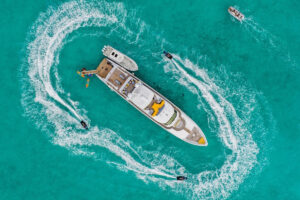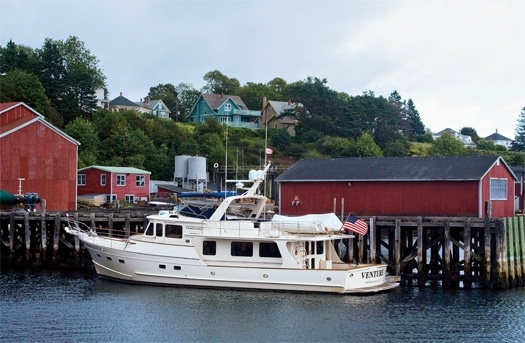
ytgnov17flem525.jpg
A significant emotional attraction compels me to begin this narrative at the end-in Halifax, Nova Scotia. This fine city is Canada’s door to the Atlantic Ocean and its window on the European Union, much the way New York City, and especially Ellis Island before the government closed that facility, is the gateway to the United States for folks from the Old Country. Prior to 1910, my father’s parents and my mother’s mother entered the U.S. via Ellis Island. My grandfather on my mother’s side entered through Canada, no doubt landing at Halifax, but he was too early in the century to have passed through immigration at Pier 21, which is on the western side of Halifax Harbor and downriver from the commercial center of the city. It is Canada’s equivalent to Ellis, and as we motored our Fleming 65, Venture, north past Pier 21, faded sepia images of the hopeful immigrants, in line to be processed, played on my mind’s eye.
Gliding into the belly of the harbor sent a chill rippling along my spine. Halifax has always triggered memories of stories I’d read about the city’s role as a staging area for overseas relief during both World Wars. On this day, I remembered the words and photos that told of an explosion in the harbor on the morning of December 6, 1917. At a little after 0900 that day, the French munitions ship Mont Blanc collided with the Norwegian ship IMO, setting the Mont Blanc on fire. In addition to her cargo of dry and liquid explosives belowdecks, the Mont Blanc carried barrels of benzol on her deck. This combination of chemicals produced the largest explosion ever made by man-until the first testing of the atomic bomb. The blast sent an enormous fireball one mile into the air, leveled the north end of Halifax, as well as parts of Dartmouth on the opposite shore, killed nearly 2,000, and wounded 9,000.
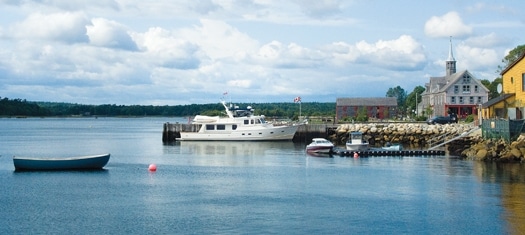
| | |
Never mind that I was aboard the luxurious Venture, in the company of her owner and builder, Tony Fleming, and the skipper, Chris Conklin-and in perfect safety-the chill persisted until we tied up at Bishop’s Landing. While I handled my share of the mooring lines, the sight of cheerful faces and the sound of animated conversations among the tourists and natives of Halifax who strolled along the boardwalk melted the chill and returned me to the present.
This adventure began in Charlottetown nine days before we entered Halifax Harbor. During the short taxi ride from the airport to the Charlottetown Yacht Club, the driver regaled me with a summary of Prince Edward Island’s attractions, among the most famous of which is the house that anchored Anne of Green Gables, the novel written by Lucy Maud Montgomery and published in 1908.
I caught up to Venture on a face dock at the yacht club. She was by far the largest yacht there and easy to spot from the parking lot. After I’d settled in, we ate the evening meal, prepared by Tony, and spent some time discussing our itinerary. After a hearty dinner, I retired to my comfortable double stateroom and fell asleep to the yacht’s gentle motion, looking forward to casting off in the morning.
The new day brought new delights-the smell of freshly brewed coffee among them. The twin MAN diesels rumbled to life, signaling our imminent departure. I’d arrived the day before just as darkness closed in so I’d missed seeing the Confederation Bridge. It spans the Northumberland Strait and connects the island with New Brunswick on the mainland. On this lovely morning in August, we motored southeast toward Cape George on the northeastern tip of Nova Scotia. A brisk northwesterly wind and following seas helped us along. Venture maintained about nine knots and handled the seas like a proper seagoing yacht, giving us a comfortable ride and time to scan the horizon for interesting landmarks. What a stately way to cruise.
Not far from Cape George, Conklin spotted a pod of pilot whales among the white caps on our starboard side. Pilot whales are relatively small, but that didn’t detract from our thrill of being within several meters of them and hearing them blow. Soon, we rounded the cape and slipped into its lee. The seas calmed, giving us a smooth and carefree run to the riprap breakwater that marks the entrance to the harbor at Ballantyne’s Cove. This tiny harbor offered only a fishand- chips shop and a modest museum devoted to swordfishing, but it was safe from rolling seas and promised a quiet night.
Friday, August 22
We cast off at 0730 and headed for St. Peter’s on Cape Breton Island at the southwestern end of the Bras d’Or Lake. A short hop across St. Georges Bay in calm weather brought us into the Canso Strait, a narrow channel that separates the island from mainland Nova Scotia, and the Canso Lock. This lock controls the tidal current in the channel and has very little rise and fall. Our approach to the lock seemed to open the gates as if by remote control. On the grassy shore to starboard, a workman aboard a small John Deere tractor cut swaths of grass, mingling the sweet smell of tortured greenery with diesel fumes.
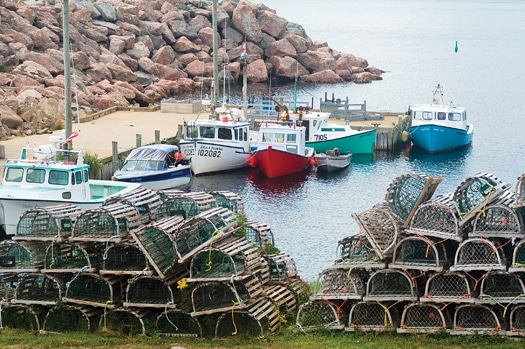
| | |
The areas on either side of the Canso Strait share a colorful industrial history. Point Tupper, a small rural community on western Cape Breton Island, got its name from Ferdinand Brock Tupper, a historian from Guernsey. In the 1880s, this town became the eastern terminal for a railcar ferry service that operated out of Mulgrave on the opposite shore of the strait. From Point Tupper, the railway ran east to Sydney, a seaport and transportation hub on the northeastern tip of the island. It has a small, but active, airport today.
Heading north into Lennox Passage, we passed Isle Madame to the east. The French colonists named the island after the second wife of King Louis XIV, Madame de Maintenon. At 16 kilometers long and 11 kilometers wide, it is home to about 4,300 people and is connected to Cape Breton Island by the Burnt Island Bridge. Peaceful is the best one-word description of this narrow roadstead. I spotted a lone angler casting from a small aluminum skiff, a pair of kayaks beached on a tiny island, and a Novi lobsterboat cruiser towing a duck boat. The skipper’s first mate, a dog wearing a canine PFD, kept watch from the bow.
Lennox Passage opens into the Bay of Rocks to the east, and within a few miles we entered St. Peter’s Canal, heading for the town of the same name and the southern end of the Bras d’Or Lake. Passing through the lock, we unsettled a group of locals seated in lawn chairs and who dangled fishing lines over the north wall of the lock. They were a jolly lot and didn’t mind our intrusion the least bit-maybe because the fish weren’t biting. At the exit to the lock, a gaggle of children amused themselves, jumping from the wall into the widening canal. Their shouts and laughter ricocheted off the lock’s walls and mingled with the songs of birds and the quiet murmur of our diesel engines.
St. Peter’s bills itself as the gateway to the Bras d’Or Lake-and so it is. It sits on the northern side of the canal and began life in the 1630s as a small fortified settlement, Sainte Pierre, founded by merchants from La Rochelle, France. In those days, the canal didn’t exist. Instead, an isthmus connected the eastern landmass with the western, a natural portage for the Mi’kmaq peoples and their canoes loaded with furs. By 1650, Nicholas Denys, also of La Rochelle, had established a trading center at Sainte Pierre. The French and British battled over control of Atlantic Canada and in 1758, the little settlement fell to the Brits. About 100 years later, the local government commissioned the 2,600-foot St. Peter’s Canal, blasted through a solid granite hill 66 feet in height. The canal opened in 1869 and has been upgraded many times, the last time in 1985. Thanks to the canal, the Bras d’Or Lake is open to the sea at both ends.
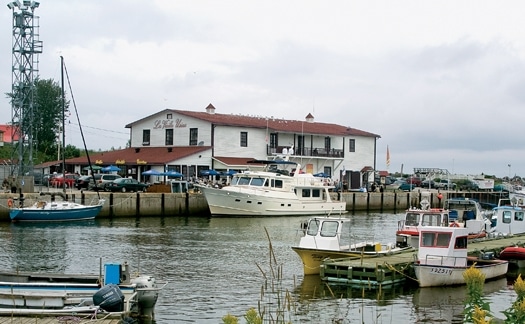
| | |
We tied up for the night at a slip in the St. Peter’s Marina, a quiet spot not far from the lock. That evening, as the sun slipped toward the horizon, the four of us walked uphill to the MacDonald Hotel, Restaurant & Bunkers Lounge for dinner. This family-style restaurant was cozy and the food good. Rooms at the St. Peter’s Country Inn, which houses the restaurant, start at $49.95 Canadian and, from the pictures I saw, seemed comfortable, if not luxurious.
Saturday, August 23
We motored north into the broad southern section of the Bras d’Or. Next stop, Baddeck, for 37 years the summer home of Alexander Graham Bell. Baddeck, a bustling community and popular destination for tourists, rises from the harbor flats the way many small New England towns do. The port authority directed us to a concrete bulkhead, to which we’d moor for the duration of our four-day visit, and told us to expect a crowd of boats to return from their poker run by evening. And return they did. The parade of boats seemed endless, and so did the variety-small, large, in-between, contemporary, and Novi-style workboats converted to pleasure use. The crews partied into the wee hours, talking and listening to country, vintage rock, and traditional Celtic music. All of us slept fitfully that night, but we didn’t grouse about it. How could we deny these folks their few moments of summer? The locals had told us earlier in our travels that summer on the Bras d’Or is short and the merrymaking intense.
We woke Sunday morning to the sounds of departure. Engines started, skippers issued commands to the line handlers, and joyful farewells filled the air. In minutes, a hush fell over the mooring basin as the pokerrun boats eased into open water and set courses for their home ports. My walkabout later in the day revealed a colorful town, dotted with B&Bs, restaurants, small shops that cater to the tourists, at least one boatyard, and a few hand-lettered marquees hawking concerts of traditional Irish, French, and Scottish music scheduled for that evening.
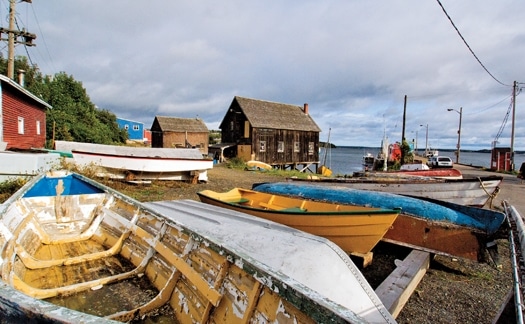
| | |
Far off the beaten path, I stumbled upon a small marina. A senior sailor had tied up his Drascombe Lugger and was striking the rig, emptying his camping gear, and generally getting ready to pull the boat from the water. Nearby, a pristine 1957 Concordia Yawl basked in the care of her owner.
Monday found us literally bouncing (shock absorbers in our rented Cavalier were worn beyond absorbing) north along the highway toward the Fortress of Louisbourg on the Atlantic side of the island. The French founded Louisbourg in 1713. By the 1740s, the town/fortress had a population of 2,500 civilians and 700 soldiers, made up of Bretons, Normans, Basques, other French, and a sprinkling of Germans, Swiss, Irish, and Africans.
From 1744 until 1763, England and France battled over Louisbourg, exchanging possession as often as the soldiers probably bathed. In 1760, the British blew up the fortifications at Louisbourg and three years later, the French ceded New France to England. In 1768, the British garrison withdrew from Louisbourg. In 1928 the Canadian government declared Louisbourg a national historic site and in 1961 began to reconstruct part of the original fortress/town. This is how we found it when we arrived on a windy, rainy, and chilly afternoon.
All of the buildings have been reconstructed in the style of the originals, often employing materials unearthed by archeologists at the site. During the tourist season, visitors get to witness reenactments of routine activities-changing of the guard and displays of public punishment among them. Visitors also may eat dinner at an 18th century restaurant, illuminated only by natural light from the doorway and a few impossibly small windows. We stopped in at a bakery, a tavern (we had a warm and spicy rum drink), the forge, the financial administrator’s palatial rooms, the King’s storehouse, and on and on. The barracks were most depressing-cramped and bleak-and made one wonder how anyone could survive the long periods of darkness during winter without bright electric lights. When we finally decided to set sail for Baddeck aboard our bouncy Cavalier, the historical significance of all we’d seen bore heavily on my soul. I looked forward to a belt of singlemalt Scotch somewhere out of the rain and wind.
Wednesday, August 27
This day began our two-day whistle-stop cruise to Halifax, accompanied on the first day by angry northeasterly winds, pewter skies, and rain. At one point during this cruise, we’d considered running north the full length of Bras d’Or Lake, entering the Atlantic at Point Aconi and heading south to visit Louisbourg. Long-range weather forecasts, calling for high winds and big seas, persuaded us to retrace our route through St. Peter’s Canal, and then head out to sea around Cape Canso, finally tucking into a small cove at Grand Greve Harbour, in the lee of the northeasterlies. At 13:45, we dropped anchor to the warbling of loons.
The next day, we weighed anchor and headed into rough seas and winds of 18 to 25 knots-weather easily shaken off by Venture. On Friday, we made the short hop to Halifax in moderate conditions. The city’s mix of modern and traditional architecture and its steep hills leading away from the harbor reminded me of Seattle or Boston. The relatively compact nature of downtown Halifax encourages visitors to walk everywhere. A person can see a great deal of the city’s façade-the outside of great historical buildings; the Fairview Lawn Cemetery, which entombs 121 victims of the sinking of the Titanic; the 19th century fortress The Citadel (a serious climb up many steps); the Old Town Clock, which seems to stand guard over the fortress; the Historic Properties, a row of shops and pubs in restored 19th century buildings; and the Naval Clock, the oldest (1772) operating naval clock in North America. You could spend a month in Halifax and never run out of sights or grow tired of the variety of restaurants, museums, and other entertainments.
Halifax was the perfect end to a wonderful cruise, and I look forward to returning. As for the Venture, she’s the perfect platform for such an adventure, and I hope I get another chance to spend time aboard her.

